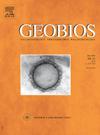Middle and Upper Ordovician linguliformean and craniiformean brachiopods from the Brabant Massif, Belgium: Infaunal giants, encrusting forms and durophagy
Abstract
Linguliformean and craniiformean brachiopods from the Middle and Upper Ordovician of the Brabant Massif (Belgium) are described for the first time and their palaeoecological and palaeobiogeographical implications are discussed. The restricted and generally poorly preserved material was collected from the Abbaye de Villers (Dapingian–Darriwilian) Formation and from the Katian Huet and Fauquez formations. The dark graptolitic mudstones of the latter unit yielded the most diverse assemblage including seven pseudolingulid, obolid, discinid, and craniopsid species while the Abbaye de Villers and Huet formations only yielded one species each. Due to the scarcity of internal morphological details available, comparison of the pseudolingulid and obolid specimens under investigation here was undertaken by running a Principal Component Analysis using a Log-Shape Ratio transformation of linear measurements. The study of valve shape changes at various growth stages helped identify these Belgian specimens at the family and generic levels. Finally, two unusually long (up to 20 mm) shell repair scars are documented in Pseudolingula and reflect predatory attacks at the anterior margin during early growth stages.

 求助内容:
求助内容: 应助结果提醒方式:
应助结果提醒方式:


